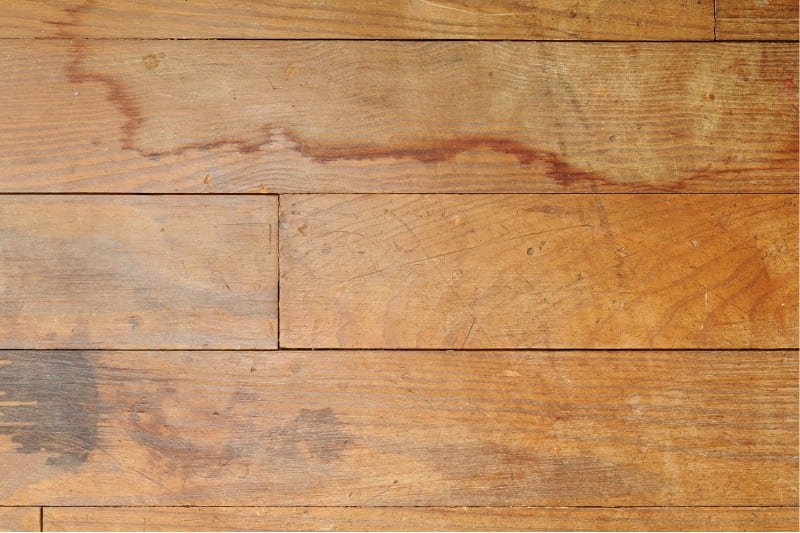Can Engineered Hardwood Get Wet?
When choosing flooring for your home, you’ll come across several options. Among them, engineered hardwood stands out as a popular choice. Homeowners often ask, “Can Engineered Hardwood Get Wet?”. In this blog, we’ll explore the moisture resistance property of engineered hardwood in detail.
Understanding Engineered Hardwood?
Engineered hardwood is a type of flooring that consists of a layer of real hardwood veneer bonded to multiple layers of plywood or high-density fiberboard (HDF). This construction enhances stability and minimizes the risk of expansion and contraction caused by fluctuations in humidity and temperature. Not only does it offer the aesthetic appeal of genuine hardwood, but it also provides increased durability and versatility.
Learn in detail in our comprehensive blog, “What is Engineered Hardwood?“

Is Engineered Hardwood Waterproof?
Engineered hardwood is water resistant but not waterproof. The finishing of the top layer of engineered hardwood consists of a water-resistant coating that helps prevent water from penetrating the surface. Although it can withstand moisture better than solid hardwood, prolonged exposure to standing water can still result in damage. It’s essential to promptly clean up spills and prevent excessive moisture in areas where you have installed engineered hardwood to maintain its integrity.
Signs That Your Engineered Hardwood Has Water Damage
Engineered hardwood flooring remains popular due to its durability and resistance to moisture. However, it’s not waterproof. Recognizing the signs of water damage can help prevent further issues and preserve the flooring’s integrity. The signs of water damage are:
- Warping or Buckling
- Swelling
- Discoloration
- Cupping
- Mold or Mildew Growth
- Soft or Spongy Areas
- Musty Odor
The Effects of Water on Engineered Hardwood
Warping
One common effect of water on engineered hardwood is the occurrence of warping or buckling. Moisture exposure can cause the planks to warp or curve, resulting in uneven surfaces and gaps between the boards.

Swelling
Engineered hardwood has the potential to swell when it absorbs moisture. This swelling causes the wood fibers to expand, leading to raised areas on the flooring surface.
Discoloration
Water damage often results in discoloration of engineered hardwood. It leads to dark spots, stains, or color changes on the surface of the flooring, diminishing its appearance.

Structural Damage
Prolonged exposure to water can weaken the structural integrity of engineered hardwood. It can cause sagging or buckling of the flooring, compromising its stability and longevity.
How to Prevent Water Damages
Prompt cleanup of spills
Ensure to clean any spills or liquids promptly. Use a soft, absorbent cloth to blot up the spill. Quick cleanup after a spill helps prevent moisture from penetrating the wood and causing damage.
Use of area rugs
Position area rugs or mats in high-traffic areas, entryways, and beneath furniture to provide extra protection for your engineered hardwood flooring. These rugs can help capture spills, dirt, and debris, reducing the risk of water damage and scratches.
Control of humidity levels
Maintain optimal humidity levels in your home to prevent excessive moisture from affecting the engineered hardwood. Use a dehumidifier, especially in humid or wet climates.
Avoidance of wet mopping
Avoid using a traditional wet mop, as excessive water can seep into the wood and cause damage. Instead, use a damp mop or specialized hardwood floor cleaner.
Application of protective coatings
Apply protective coatings such as polyurethane or wax to create a barrier against moisture and spills to your engineered hardwood flooring. These coatings help seal the surface of the wood, making it more resistant to water damage and easier to clean.

Addressing Water Damages
Assessment of damage
Begin by assessing the extent of the water damage to your engineered hardwood flooring. Look for signs of warping, swelling, discoloration, or soft spots. Identify the specific areas that have been affected and determine the severity of the damage.
Drying out the affected area
Once you have assessed the damage, it’s crucial to dry out the affected area promptly to prevent further wear. Use fans, dehumidifiers, or natural ventilation to speed up drying. Avoid using heat sources like heaters or hair dryers, as they can cause further damage to the wood.
Replacement of damaged planks
If cases where the water damage is severe, it may be necessary to replace the damaged planks. Take care to remove the affected planks without causing any harm to the surrounding areas and replace them with new ones that match the existing flooring.

Consulting professionals, if needed
If you’re uncertain how to address the water damage or if the damage is extensive, it’s advisable to seek guidance from professionals such as flooring contractors or water damage restoration specialists.
Should You Fix or Replace Your Engineered Hardwood?
When deciding whether to repair or replace your engineered hardwood flooring, assessing the damage’s extent and evaluating the floor’s overall condition is essential. Minor issues, like small scratches or damaged patches, can be easily fixed by sanding, filling, and refinishing. However, suppose the damage is extensive, such as widespread warping, swelling, or structural issues. In that case, doing a full replacement may be more practical. Additionally, factors such as the age and condition of the flooring, as well as your budget and preferences, should also be considered when making this decision.
The Final Verdict: Engineered Hardwood vs. Water
So, is it possible for engineered hardwood to get wet? While engineered hardwood is more moisture-resistant than solid hardwood, it’s not completely waterproof. Long exposure to standing water or high humidity levels can result in issues such as warping, swelling, and discoloration. However, by taking proactive measures to prevent water damage and promptly addressing any spills or moisture buildup, you can help preserve the beauty and durability of your engineered hardwood flooring.
It’s important to remember that the quality of the replacement planks or new flooring options you choose makes a difference. At Villagio Wood Floors, we offer a wide selection of high-quality engineered hardwoods that smoothly blend with your existing flooring. We have designed our products with both aesthetics and durability in mind, ensuring they withstand the challenges of everyday life, including those occasional spills. Check our collection today and upgrade your space.
Can Engineered Hardwood Get Wet – FAQs
Can engineered hardwood be wet-mopped?
We do not recommend engineered hardwood wet mopping, as it can allow excessive moisture to seep into the wood and cause damage. Instead, clean the floors with a damp mop or a specialized hardwood floor cleaner, avoiding excess water saturation.
What’s the best way to clean engineered hardwood floors?
To clean engineered hardwood floors effectively, it is best to regularly sweep or vacuum using a brush attachment to remove dirt and debris. Use a damp mop or a specialized hardwood floor cleaner for more thorough cleaning.
Learn to clean and maintain your hardwood flooring in our other blog, “How To Clean Engineered Hardwood Floors?“
Is engineered hardwood high maintenance?
Engineered hardwood flooring typically requires less maintenance than other flooring options. However, it still requires regular cleaning and maintenance to preserve its appearance and longevity. By adhering to a consistent cleaning routine and promptly addressing any spills or damage, you can ensure your engineered hardwood retains its quality for years.
Do engineered wood floors scratch easily?
While engineered hardwood is more resistant to scratching and denting, it is not entirely scratch-proof. Sharp objects or heavy furniture can still cause scratches on engineered hardwood floors. Using furniture pads and area rugs and exercising caution when moving furniture can help prevent scratches and maintain the appearance of your floors.
What is the lifespan of engineered hardwood?
The lifespan of engineered hardwood flooring can vary depending on factors such as the quality of the materials, installation, and maintenance. On average, a well-maintained engineered hardwood floor lasts 20 to 30 years.
















